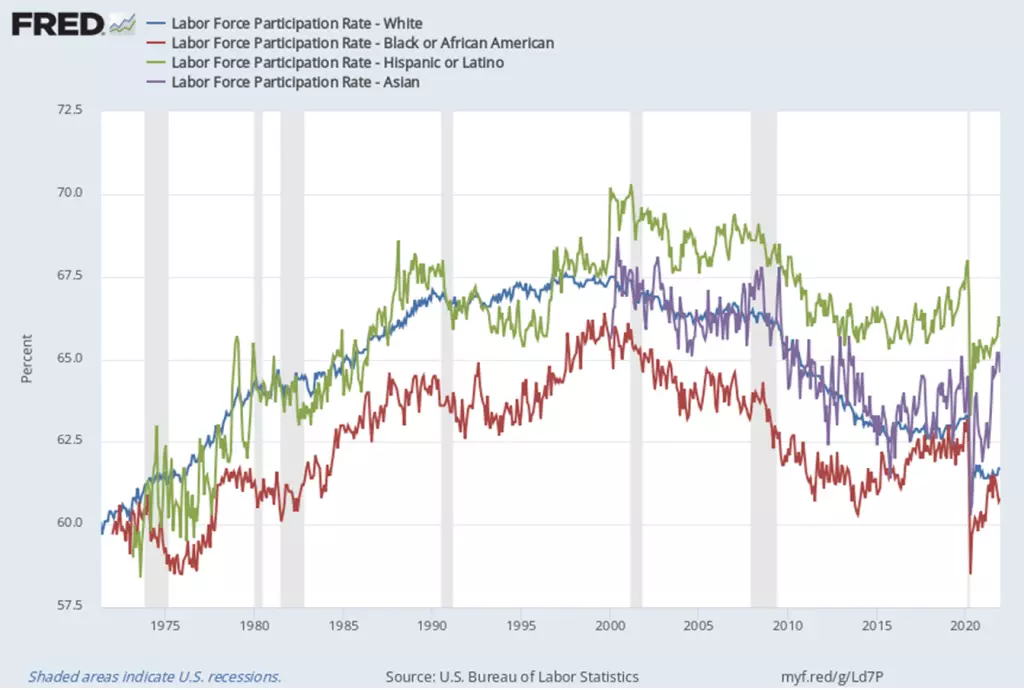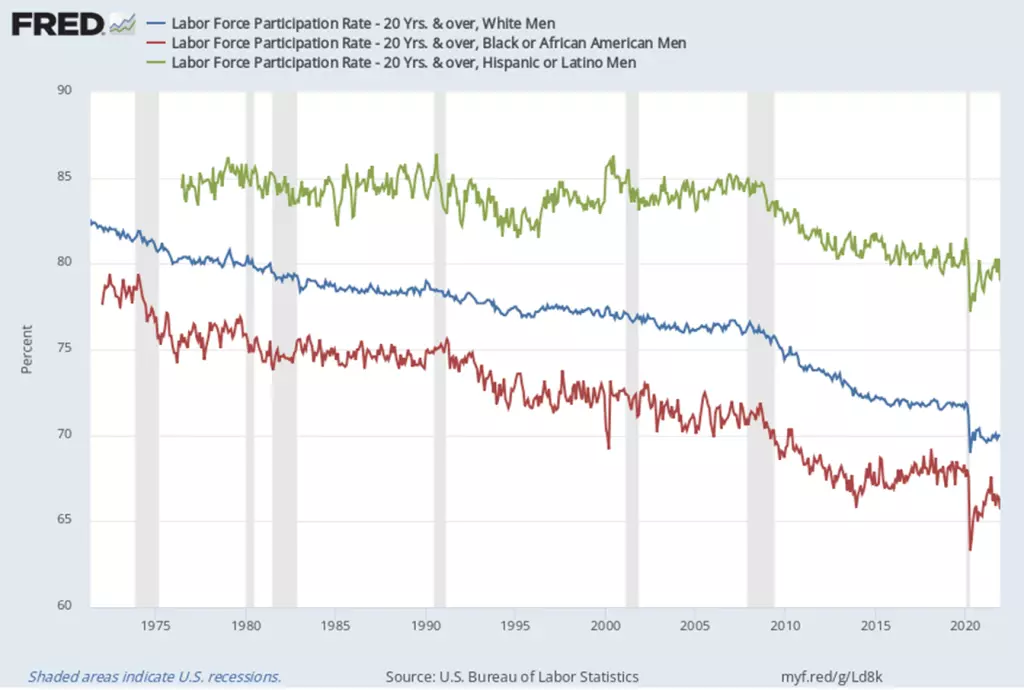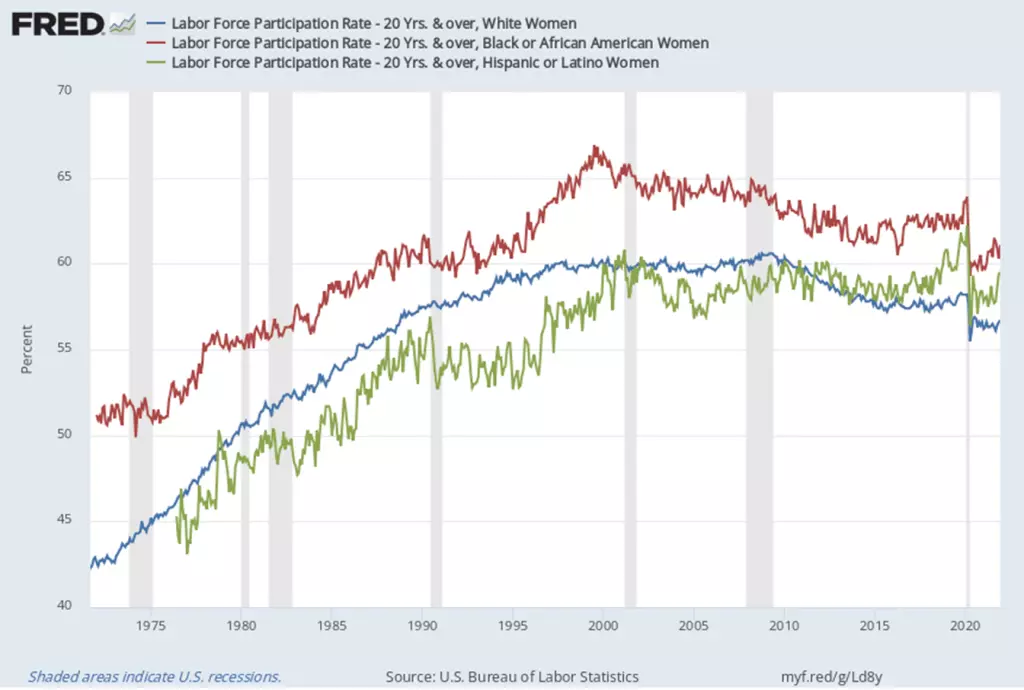Comments
- No comments found

With “the Great Resignation”–that is, the rise in people since the pandemic who are out of the labor force and neither employed nor looking for work–it’s perhaps useful to point out some substantial shifts in racial differences in labor force participation.
This figure shows overall labor force participation for white (blue line), black (red line), Hispanic (green line), and Asian (purple line) workers. Separate data on Asian workers has only been collected since about 2002. But back in the early 1970s, labor force participation rates were quite similar for white, black, and Hispanic populations. Labor force participation then rose for all three groups in the 1970s, 1980s, and 1990s, in large part because of the mass entry of women to the (paid) labor force. However, the rise in labor force participation for whites and Hispanics was faster than the rise for blacks. Roughly around 2000, the labor force participation rate for all three groups started declining. However, the decline was slowest for the Hispanic population. In the lead-up to the pandemic, labor force participation was highest for the Hispanic population, but had roughly equalized for the white, black, and Asian population.

In looking at labor force statistics, it’s standard to separate out men and women. This graph shows labor force participation rates for white, black, and Hispanic men. (Data for Asian men and women is not readily available.) The general pattern is that the labor force participation rate is falling for all groups of men over time. However, the decline for Hispanic men is less, and the decline in labor force participation for white men since about 2010 is especially pronounced.

Here’s the parallel figure for labor force participation of white, black, and Hispanic women. For all three groups, the rise in female labor force participation from the 1970s up to around 2000 is apparent. However, in this case the labor force participation rate of black women (red line) is consistently above that of white women (blue line). The rate of labor force participation of Hispanic women (green line) was generally below that of white women for most of the period, but rose above white women around 2010.

I won’t attempt here to offer explanations (or gross generalizations) behind these patterns. But it is notable to me that labor force participation for Hispanics is now higher than that for whites for both men and women. It is notable that labor force participation rates for blacks have converged with those for whites, in large part because the drop in white labor force participation for both men and women in the last decade or so has been so substantial. It will be interesting to see if the Asian labor force participation rate continues to track the rate for whites, as it did before the pandemic, or if it moves to the higher levels of Hispanic labor force participation, as it seems to be doing since the pandemic.
Timothy Taylor is an American economist. He is managing editor of the Journal of Economic Perspectives, a quarterly academic journal produced at Macalester College and published by the American Economic Association. Taylor received his Bachelor of Arts degree from Haverford College and a master's degree in economics from Stanford University. At Stanford, he was winner of the award for excellent teaching in a large class (more than 30 students) given by the Associated Students of Stanford University. At Minnesota, he was named a Distinguished Lecturer by the Department of Economics and voted Teacher of the Year by the master's degree students at the Hubert H. Humphrey Institute of Public Affairs. Taylor has been a guest speaker for groups of teachers of high school economics, visiting diplomats from eastern Europe, talk-radio shows, and community groups. From 1989 to 1997, Professor Taylor wrote an economics opinion column for the San Jose Mercury-News. He has published multiple lectures on economics through The Teaching Company. With Rudolph Penner and Isabel Sawhill, he is co-author of Updating America's Social Contract (2000), whose first chapter provided an early radical centrist perspective, "An Agenda for the Radical Middle". Taylor is also the author of The Instant Economist: Everything You Need to Know About How the Economy Works, published by the Penguin Group in 2012. The fourth edition of Taylor's Principles of Economics textbook was published by Textbook Media in 2017.
Leave your comments
Post comment as a guest